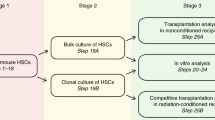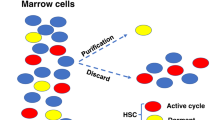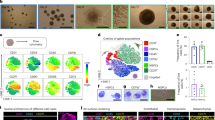Abstract
In this paper, we describe a protocol for hematopoietic differentiation of human pluripotent stem cells (hPSCs) and generation of mature myeloid cells from hPSCs through expansion and differentiation of hPSC-derived lin−CD34+CD43+CD45+ multipotent progenitors. The protocol comprises three major steps: (i) induction of hematopoietic differentiation by coculture of hPSCs with OP9 bone marrow stromal cells; (ii) short-term expansion of multipotent myeloid progenitors with a high dose of granulocyte-macrophage colony-stimulating factor; and (iii) directed differentiation of myeloid progenitors into neutrophils, eosinophils, dendritic cells, Langerhans cells, macrophages and osteoclasts. The generation of multipotent hematopoietic progenitors from hPSCs requires 9 d of culture and an additional 2 d to expand myeloid progenitors. Differentiation of myeloid progenitors into mature myeloid cells requires an additional 5–19 d of culture with cytokines, depending on the cell type.
This is a preview of subscription content, access via your institution
Access options
Subscribe to this journal
Receive 12 print issues and online access
$259.00 per year
only $21.58 per issue
Buy this article
- Purchase on Springer Link
- Instant access to full article PDF
Prices may be subject to local taxes which are calculated during checkout




Similar content being viewed by others
References
Thomson, J.A. et al. Embryonic stem cell lines derived from human blastocysts. Science 282, 1145–1147 (1998).
Takahashi, K. & Yamanaka, S. Induction of pluripotent stem cells from mouse embryonic and adult fibroblast cultures by defined factors. Cell 126, 663–676 (2006).
Takahashi, K. et al. Induction of pluripotent stem cells from adult human fibroblasts by defined factors. Cell 131, 861–872 (2007).
Yu, J. et al. Induced pluripotent stem cell lines derived from human somatic cells. Science 318, 1917–1920 (2007).
Chadwick, K. et al. Cytokines and BMP-4 promote hematopoietic differentiation of human embryonic stem cells. Blood 102, 906–915 (2003).
Ng, E.S., Davis, R.P., Azzola, L., Stanley, E.G. & Elefanty, A.G. Forced aggregation of defined numbers of human embryonic stem cells into embryoid bodies fosters robust, reproducible hematopoietic differentiation. Blood 106, 1601–1603 (2005).
Zambidis, E.T., Peault, B., Park, T.S., Bunz, F. & Civin, C.I. Hematopoietic differentiation of human embryonic stem cells progresses through sequential hematoendothelial, primitive, and definitive stages resembling human yolk sac development. Blood 106, 860–870 (2005).
Kaufman, D.S., Hanson, E.T., Lewis, R.L., Auerbach, R. & Thomson, J.A. Hematopoietic colony-forming cells derived from human embryonic stem cells. Proc. Natl. Acad. Sci. USA 98, 10716–10721 (2001).
Qiu, C. et al. Differentiation of human embryonic stem cells into hematopoietic cells by coculture with human fetal liver cells recapitulates the globin switch that occurs early in development. Exp. Hematol. 33, 1450–1458 (2005).
Ledran, M.H. et al. Efficient hematopoietic differentiation of human embryonic stem cells on stromal cells derived from hematopoietic niches. Cell Stem Cell 3, 85–98 (2008).
Vodyanik, M.A., Bork, J.A., Thomson, J.A. & Slukvin, I.I. Human embryonic stem cell-derived CD34+ cells: efficient production in the coculture with OP9 stromal cells and analysis of lymphohematopoietic potential. Blood 105, 617–626 (2005).
Wang, Z.Z. et al. Endothelial cells derived from human embryonic stem cells form durable blood vessels in vivo. Nat. Biotechnol. 25, 317–318 (2007).
Timmermans, F. et al. Generation of T cells from human embryonic stem cell-derived hematopoietic zones. J. Immunol. 182, 6879–6888 (2009).
Galic, Z. et al. T lineage differentiation from human embryonic stem cells. Proc. Natl. Acad. Sci. USA 103, 11742–11747 (2006).
Takayama, N. et al. Generation of functional platelets from human embryonic stem cells in vitro via ES-sacs, VEGF-promoted structures that concentrate hematopoietic progenitors. Blood 111, 5298–5306 (2008).
Gaur, M. et al. Megakaryocytes derived from human embryonic stem cells: a genetically tractable system to study megakaryocytopoiesis and integrin function. J. Thromb. Haemost. 4, 436–442 (2006).
Martin, C.H., Woll, P.S., Ni, Z., Zuniga-Pflucker, J.C. & Kaufman, D.S. Differences in lymphocyte developmental potential between human embryonic stem cell and umbilical cord blood-derived hematopoietic progenitor cells. Blood 112, 2730–2737 (2008).
Choi, K. et al. Hematopoietic and endothelial differentiation of human induced pluripotent stem cells. Stem Cells 27, 559–567 (2009).
Vodyanik, M.A., Thomson, J.A. & Slukvin, I.I. Leukosialin (CD43) defines hematopoietic progenitors in human embryonic stem cell differentiation cultures. Blood 108, 2095–2105 (2006).
Klimchenko, O. et al. A common bipotent progenitor generates the erythroid and megakaryocyte lineages in embryonic stem cell-derived primitive hematopoiesis. Blood 114, 1506–1517 (2009).
Choi, K.D., Vodyanik, M.A. & Slukvin, I.I. Generation of mature human myelomonocytic cells through expansion and differentiation of pluripotent stem cell-derived lin-CD34+CD43+CD45+ progenitors. J. Clin. Invest. 119, 2818–2829 (2009).
Vodyanik, M.A. & Slukvin, I.I. Hematoendothelial differentiation of human embryonic stem cells. Curr. Protoc. Cell. Biol. 36, 23.6.1–23.6.28 (2007).
Vodyanik, M.A. & Slukvin, I.I. Directed differentiation of human embryonic stem cells to dendritic cells. Methods Mol. Biol. 407, 275–293 (2007).
Karlsson, K.R. et al. Homogeneous monocytes and macrophages from human embryonic stem cells following coculture-free differentiation in M-CSF and IL-3. Exp. Hematol. 36, 1167–1175 (2008).
Su, Z., Frye, C., Bae, K.M., Kelley, V. & Vieweg, J. Differentiation of human embryonic stem cells into immunostimulatory dendritic cells under feeder-free culture conditions. Clin. Cancer Res. 14, 6207–6217 (2008).
Senju, S. et al. Genetically manipulated human embryonic stem cell-derived dendritic cells with immune regulatory function. Stem Cells 25, 2720–2729 (2007).
Grigoriadis, A.E. et al. Directed differentiation of hematopoietic precursors and functional osteoclasts from human ES and iPS cells. Blood 115, 2769–2776 (2010).
Yokoyama, Y. et al. Derivation of functional mature neutrophils from human embryonic stem cells. Blood 113, 6584–6592 (2009).
Saeki, K. et al. A feeder-free and efficient production of functional neutrophils from human embryonic stem cells. Stem Cells 27, 59–67 (2009).
Clark, R.A. & Nauseef, W.M. Isolation and functional analysis of neutrophils. Curr. Protoc. Immunol. (2001).
Yona, S., Hayhoe, R. & Avraham-Davidi, I. Monocyte and neutrophil isolation and migration assays. Curr. Protoc. Immunol. 88, 14.15.1–14.15.14 (2010).
Harding, C.V. & Ramachandra, L. Presenting exogenous antigen to T cells. Curr. Protoc. Immunol. 88, 16.2.1–16.2.18 (2010).
Yu, J. et al. Human induced pluripotent stem cells free of vector and transgene sequences. Science 324, 797–801 (2009).
Ludwig, T.E. et al. Feeder-independent culture of human embryonic stem cells. Nat. Methods 3, 637–646 (2006).
Acknowledgements
This study is supported by funds from the National Heart, Lung, and Blood Institute (R01 HL081962, R21 HL085223) and by National Institutes of Health grant P51RR000167 to the National Primate Research Center, University of Wisconsin, Madison. We thank T. Nakano for providing OP9 cells.
Author information
Authors and Affiliations
Contributions
K.-D.C. designed and performed the experiments, analyzed the data and wrote the paper. M.V. designed and performed the experiments. I.I.S. supervised the project, designed the experiments, analyzed data and wrote the paper.
Corresponding author
Ethics declarations
Competing interests
I.I.S. owns stock and is a scientific founder of Cellular Dynamics International.
Rights and permissions
About this article
Cite this article
Choi, KD., Vodyanik, M. & Slukvin, I. Hematopoietic differentiation and production of mature myeloid cells from human pluripotent stem cells. Nat Protoc 6, 296–313 (2011). https://doi.org/10.1038/nprot.2010.184
Published:
Issue Date:
DOI: https://doi.org/10.1038/nprot.2010.184
This article is cited by
-
Generating hematopoietic cells from human pluripotent stem cells: approaches, progress and challenges
Cell Regeneration (2023)
-
Functions, mechanisms, and therapeutic implications of METTL14 in human cancer
Journal of Hematology & Oncology (2022)
-
Continuous human iPSC-macrophage mass production by suspension culture in stirred tank bioreactors
Nature Protocols (2022)
-
Wiskott-Aldrich syndrome protein forms nuclear condensates and regulates alternative splicing
Nature Communications (2022)
-
Overexpression of HOXA9 upregulates NF-κB signaling to promote human hematopoiesis and alter the hematopoietic differentiation potentials
Cell Regeneration (2021)
Comments
By submitting a comment you agree to abide by our Terms and Community Guidelines. If you find something abusive or that does not comply with our terms or guidelines please flag it as inappropriate.



